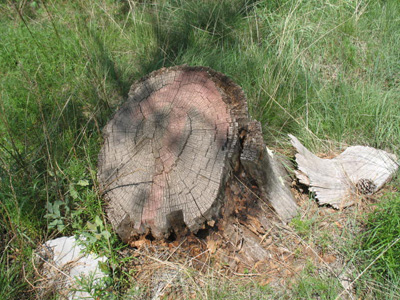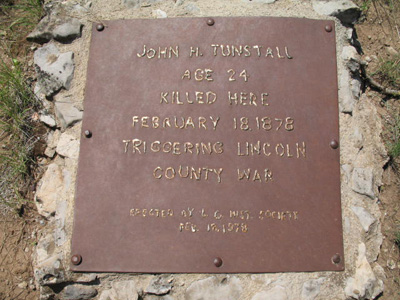
 John Henry TunstallOn the morning of February 18, 1878 24 year old John Tunstall learned that a posse sent by Sheriff Brady was on it's way to attach his cattle. Tunstall decided not to remain at the ranch as to resist the attachment. So around 8:00 in the morning Tunstall along with William Bonney, Richard Brewer, John Middleton, Fred Waite, and Rob Widennmann started towards Lincoln with nine horses and two mules that Sheriff Brady had exempted from the attachment a few days before, stating that they were exempt, because they were indisputably Tunstall's personal property. One of the horses belonged to William Bonney and two others belonged to Richard Brewer. Fred Waite who was driving the wagon split off from the rest of Tunstall's men about ten miles out. Tunstall nd his men took the short cut through Pajarito Flats. When the posse lead by Billy Mathews reached Tunstall's ranch they learned that Tunstall had already left driving his horses back to Lincoln.
John Henry TunstallOn the morning of February 18, 1878 24 year old John Tunstall learned that a posse sent by Sheriff Brady was on it's way to attach his cattle. Tunstall decided not to remain at the ranch as to resist the attachment. So around 8:00 in the morning Tunstall along with William Bonney, Richard Brewer, John Middleton, Fred Waite, and Rob Widennmann started towards Lincoln with nine horses and two mules that Sheriff Brady had exempted from the attachment a few days before, stating that they were exempt, because they were indisputably Tunstall's personal property. One of the horses belonged to William Bonney and two others belonged to Richard Brewer. Fred Waite who was driving the wagon split off from the rest of Tunstall's men about ten miles out. Tunstall nd his men took the short cut through Pajarito Flats. When the posse lead by Billy Mathews reached Tunstall's ranch they learned that Tunstall had already left driving his horses back to Lincoln.
 This is John Henry Tunstall's writing case. It has been donated
This is John Henry Tunstall's writing case. It has been donated
to the Tunstall Store Museum by the Tunstall family and is currently on display there.
Matthews then instructed a 14 man sub-posse which included Morton, Robert Beckwith, Wallace Ollinger, Sam Perry, Dutch Charley Kruling, Thomas Cochrane, Juan Segovia, Thomas Green, Gallegos, John Hurley, Charles Marshall, Manuel Kitt, Ramon Montoya, George Hindman, and three unofficial posse members; Frank Baker, Jesse Evans, and Tom Hill. Morton told them he didn't want them going to which evans supposedly replied, "We aren't going with you. We are here for our own business. We are after our horses, which have been loaned to "Kid Antrim." After several hours on the trail the posse is very strung out but catches up with Tunstall and his men. Brewer and Widenmann had just went after a fock of wild turkeys that they had spotted and Bonney and Middleton are riding drag behind the others, when they hear the posse approaching. Supposedly the posse rode up firing and Tunstall's men quickly fled to a nearby hill for defense
 John Tunstall's personal hygeine and grooming case. This item is currently on display in
John Tunstall's personal hygeine and grooming case. This item is currently on display in
Don Sweet's excellent Billy the Kid Museum in downtown Fort Sumner, New Mexico.
Middleton recalled "I sung out for Tunstall to follow me. He was on a good horse; he appeared to be very much excited and confused. I kept singing out to him, 'For God's sake, follow me.' His last words were, "What John? What, John?" The sub-posse quickly gave up on pursuing the others and rode towards Tunstall. According to posse member George Kitt, "Tunstall was some distance off and was coming towards them. Hill called to him to come up and that he would not be hurt, at the same time both Hill and Morton threw up their guns resting the stocks on their knees. Morton wished to shoot him and Hill said hold on till he comes nearer. After Tunstall came a little nearer Morton shot him in the breast and then Hill shot him in the head." Supposedly Kitt also claimed that Tunstall fired no shots and was killed in cold blood. Just exactly how Tunstall was killed will probably never be known. Some accounts claim that after being shot in the chest by Morton, that Jesse Evans rode up and and dismounted. After which he supposedly snatched Tunstall's revolver and fired a shot into the back of his head and then another into his horses head. The posse later claimed that Tunstall was killed after firing at them and resisting arrest. The brutal murder of John Tunstall was the spark that ignited what has come to be known as the Lincoln County War.
 This is the historical marker located on Highway 70 near Glencoe. This marker is for the casual tourist.
This is the historical marker located on Highway 70 near Glencoe. This marker is for the casual tourist.
The actual murder site is a few miles away from this marker and much higher up in the mountains.(See photos below)

This is looking down into Tunstall Canyon. As you can see this is a
very hard site to reach, because it is way up in the mountains and can be very hard to find.

As you walk down the mountain road and descend down into the canyon
you will be guided to the site by two red arrows that have been painted on tree stumps. This is the first of the two.

This is the second and last arrow that you will see on your way to the site.

This is the new sign recently placed at the site by the Forest Service.

This is the site where Tunstall was killed by a posse that was on the side of Jimmy Dolan and
Company on February 18, 1878, triggering the violence that has come to be known as the Lincoln County War.

This is a much earlier photo of the Tunstall murder site that appeared in Regulator George Coe's
autobiography "Frontier Fighter". Note that at this time the site was only marked with a pile of rocks.

This is a close up of the historical marker on the ground.

Lucas Speer with researcher/author Donna Tatting and
her husband Gary at the Tunstall Murder Site on July 22, 2006.














